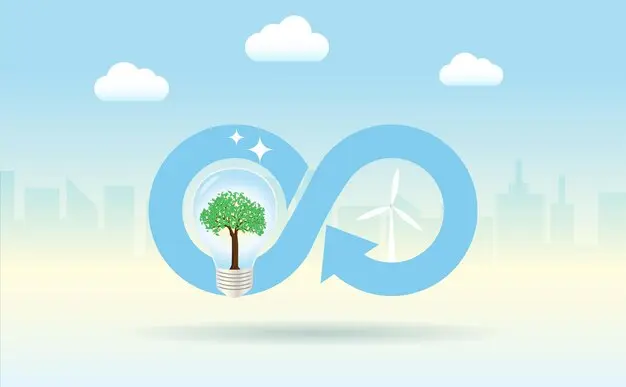In the face of escalating climate change, the need to decrease our carbon footprint has never been more urgent. As conscious homeowners, newlyweds, and sustainability enthusiasts, we all have a role to play in this global effort. But where do we start? The answer lies in sustainable energy.
Sustainable energy is not just a buzzword; it’s a lifestyle change that can significantly reduce our carbon footprint and contribute to a healthier planet. It’s about harnessing renewable energy sources like wind, solar, and geothermal power, which are not only abundant and renewable but also emit significantly fewer greenhouse gases compared to fossil fuels.
This blog post will guide you through practical and effective ways to decrease your carbon footprint using sustainable energy. We’ll explore energy-efficient practices for your home, sustainable transportation options, eco-friendly eating and shopping habits, and the power of activism and nature-based solutions.
Whether you’re a young adult, a new homeowner, or an environmentalist, this guide will provide you with the knowledge and tools you need to make a positive impact on our planet. So, let’s embark on this journey towards a more sustainable future together.
Remember, every step we take towards sustainability is a step towards a healthier planet. Let’s start decreasing our carbon footprint with sustainable energy today!
Key Takeaways
- Embrace Energy Efficiency: Using energy-efficient appliances and properly insulating your home can significantly reduce energy consumption and, consequently, your carbon footprint.
- Opt for Sustainable Transportation: Choosing to walk, bike, use public transport, or ride-share can drastically reduce the emissions associated with personal vehicle use.
- Adopt a Sustainable Diet: Consuming locally sourced, seasonal produce and reducing meat consumption can lower the carbon footprint associated with your food.
- Support Sustainable Companies: By choosing to buy from companies that prioritize sustainable practices, you can help drive the demand for environmentally friendly products and services.
- Become an Active Advocate: Participating in campaigns, voting for green policies, and supporting companies that prioritize sustainability can lead to significant changes on a larger scale.
- Protect and Restore Nature: Supporting initiatives that protect and restore forests, wetlands, and other natural habitats can help absorb carbon dioxide from the atmosphere.
- Scale Up Renewable Energy Use: Supporting policies and companies that promote renewable energy can help replace fossil fuels in electricity generation, reducing carbon emissions.
Understanding Carbon Footprint and Sustainable Energy
Before we delve into the practical steps, let’s first understand what a carbon footprint is and why sustainable energy is crucial. A carbon footprint refers to the total amount of greenhouse gases, including carbon dioxide, that are emitted into the atmosphere due to human activities. This could be from driving a car, using electricity produced from fossil fuels, or even from the food we eat.
Climate change, a pressing global issue, is primarily driven by these greenhouse gas emissions. As the gases trap heat in the earth’s atmosphere, they contribute to global warming, leading to a host of environmental issues, including rising sea levels, extreme weather events, and loss of biodiversity.
This is where sustainable energy comes into play. Sustainable energy refers to sources of energy that are naturally replenished and have a lower environmental impact. This includes solar power, wind energy, hydroelectric power, and geothermal energy. By harnessing these renewable energy sources, we can significantly reduce our carbon emissions and mitigate the effects of climate change.
Reducing Energy Consumption at Home
One of the most effective ways to reduce your carbon footprint is by decreasing energy consumption at home. Energy efficiency is key here. This means using less energy to perform the same tasks, thereby reducing the demand for electricity and fossil fuels.
Start by switching to energy-efficient appliances, such as LED lights, energy-saving refrigerators, and low-flow showerheads. These appliances use significantly less energy compared to their conventional counterparts, leading to lower greenhouse gas emissions.
Consider insulating your home properly. Good insulation keeps your home warm during the winter and cool during the summer, reducing the need for heating and air conditioning.
Moreover, embrace renewable energy sources. If feasible, install solar panels or a solar water heater in your home. These systems use the sun’s energy to generate electricity or heat water, reducing your reliance on fossil fuels.
Sustainable Transportation
Transportation is a significant contributor to global carbon emissions. However, there are several sustainable practices we can adopt to mitigate this.
Walking or biking for short distances not only reduces carbon emissions but also provides excellent physical exercise. For longer distances, consider using public transportation. Buses, trams, and trains carry many people at once, making them more energy-efficient than individual cars.
If you need to use a car, consider ride-sharing or carpooling. This reduces the number of vehicles on the road, leading to lower emissions per person. Better yet, if you’re considering buying a new car, look into electric vehicles. They produce zero tailpipe emissions and are more energy-efficient than conventional cars.
Sustainable Eating Habits
Our food choices also have a significant impact on our carbon footprint. The production, transportation, and storage of food all contribute to greenhouse gas emissions.
Try to consume local and seasonal products. These products don’t have to travel long distances, reducing carbon emissions from transportation. Also, local produce is often fresher and more nutritious.
Limiting meat consumption, especially beef, can also significantly reduce your carbon footprint. Livestock farming is a major contributor to greenhouse gas emissions, and beef is particularly high due to the methane produced by cattle.
Sustainable Shopping Practices
Our shopping habits can also contribute to our carbon footprint. By making mindful choices, we can reduce this impact.
Firstly, try to buy only what you need to avoid waste. Waste not only contributes to landfill but also represents a waste of the energy used to produce discarded items.
When shopping, bring reusable bags and avoid products with excessive plastic packaging. Plastic production is energy-intensive and contributes to pollution.
The Power of Activism
While individual actions are crucial, collective action can lead to significant changes on a larger scale. This is where activism comes in. By campaigning and voting, we can influence policies and practices toward more sustainable ones.
Support companies that prioritize sustainability. These companies understand their environmental impact and take steps to reduce it. This could be through energy-efficient operations, using renewable energy, or offering products and services that are environmentally friendly.
Join climate marches, sign petitions, and support sustainable practices through activism. These actions raise awareness and put pressure on governments and corporations to prioritize sustainability.
Nature-Based Solutions
Nature itself offers powerful solutions to reduce our carbon footprint. Protecting and restoring nature can help absorb carbon dioxide from the atmosphere, acting as a natural carbon sink.
Plant trees and create green spaces in your local community. Trees absorb carbon dioxide and release oxygen, helping to reduce greenhouse gases in the atmosphere.
Support initiatives that protect and restore forests, wetlands, and other natural habitats. These ecosystems are vital for our planet’s health and act as natural carbon sinks.
Scaling Up Renewable Energy
Finally, we need to scale up the use of renewable energy. Renewable energy sources like wind, solar, and hydropower do not emit carbon dioxide during operation and can replace fossil fuels in electricity generation.
Support policies and companies that promote renewable energy. This could be through voting, investing in renewable energy companies, or choosing a green energy plan for your home.
Conclusion
Decreasing your carbon footprint with sustainable energy is not only possible but also essential for our planet’s future. By making conscious choices in our homes, transportation, diet, and shopping habits, and supporting sustainable policies and companies, we can all contribute to a healthier and more sustainable world.
Remember, every small step counts. Let’s start decreasing our carbon footprint with sustainable energy today!
Frequently Asked Questions (FAQs)
-
How does sustainability reduce carbon footprint?
Sustainability reduces carbon footprint by promoting the use of renewable energy sources, encouraging energy efficiency, and advocating for practices that minimize waste and environmental harm.
-
What is the carbon footprint of sustainable energy?
The carbon footprint of sustainable energy is significantly lower than that of fossil fuels. While there are some emissions associated with the production and installation of renewable energy systems, the operation of these systems does not produce greenhouse gases.
-
How does clean energy reduce your carbon footprint?
Clean energy reduces your carbon footprint by replacing fossil fuels, which are major sources of greenhouse gas emissions. Renewable energy sources like wind, solar, and hydropower do not emit carbon dioxide during operation.
-
Can carbon footprint be reduced with green energy fuel?
Yes, green energy fuels such as biofuels and hydrogen can help reduce carbon footprint. These fuels are produced from renewable resources and emit fewer greenhouse gases compared to fossil fuels.

